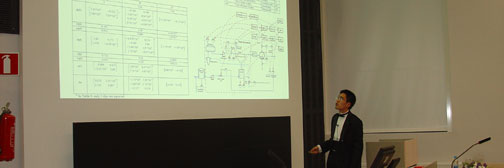| | Year 2001
Ismo Laukkanen STUDIES IN USING HYBRID DYNAMIC SIMULATION THROUGH THE LIFE-CYCLE OF PAPER MILL
This study focuses on the applications of hybrid dynamic simulation in the paper industry. The principles of modelling the paper machine process are introduced. A dynamic, hybrid simulator consists of continuous, discrete time, discrete event and static models which are used to model a thermohydraulic network and paper machine submodels. The simulator developed in this study was incorporated in a program called APMS, which was used as a modelling environment in this study.
A mathematical simulation model of the paper machine process was developed during the paper machine design project. The goal of modelling was to analyse the process dynamics of the new paper machine, including new process and control design concepts. There were no industrial scale experiences on the controllability of similar processes available. The combined response of the process equipment and the control system under transient operation conditions was investigated; both major process equipment and paper mill control structures were included in the simulator. Both normal and transient operation of the process were verified. As a result, the faulty operation of two control circuits was identified. Redesign and fine-tuning could be carried out before the initial start-up. It was estimated that 0.5 - 1 day troubleshooting time was saved.
The first application for the simulator was operator training, including training in normal, grade change, web break and process disturbance situations. A real process control system (Valmet Damatic XD) was used to operate the training simulator. As a result of simulator training, the start-up of the machine was very easy and the operators responsible for running the machine learnt how to operate the new process. The training turned out to be too difficult for some operators. On the basis of these results, a web-based multimedia learning environment called KnowPap was developed. The usability of KnowPap, both in classroom training and for individual study, was investigated. It turned to be out a very good training tool for initial and intermediate training, while the full scope simulator is a good tool for advanced operator training.
The simulator was next used in process analysis studies. A problem, which has been reported in many paper mills, concerning consistency fluctuations of save-all filtrates was studied. The reason, a rapid change in the blend chest level was identified, using the simulator. The change causes disturbances in the sweetener stock composition and in the save-all filter operation. The short and long term effects of the change are observed as fluctuating filtrate consistencies and fluctuations in paper quality properties, respectively.
Based on these results, we propose that by the optimally use of hybrid models, the life cycle of the simulator follows the life cycle of the paper machine. The hybrid simulator is multifunctional, fulfilling the requirements of process and control engineering, operator training, research and process analysis applications. As a result, the quality of the design, training and process operation can be improved. All applications can be performed before the start-up of the machine, which is possible because mechanistic high-fidelity hybrid models are used. This is a very important characteristic, which makes its industrial use both practically and economically feasible. The extended life-cycle concept was tested on the industrial scale case study.
Dynamic process simulation, based on hybrid models, turned out to be a powerful tool for verification of design, for operator training and process analysis. In future, it will provide a strong basis for the virtual paper machine and paper product development environments as well as for advanced multimedia-training systems.
Deprecated: strlen(): Passing null to parameter #1 ($string) of type string is deprecated in C:\WWWroot\Root\incs\5_theses\theses_new2010.php on line 248
This info last modified 28 Apr 2024 - contact webmaster
|

